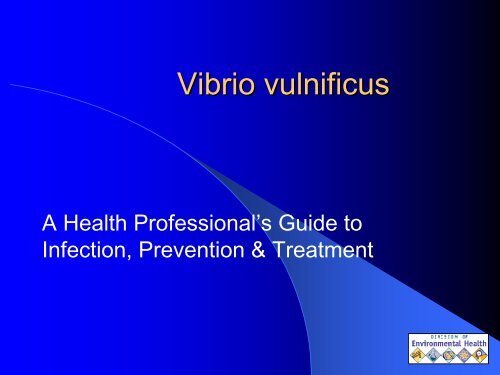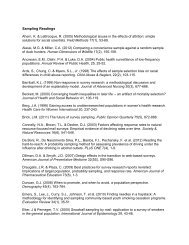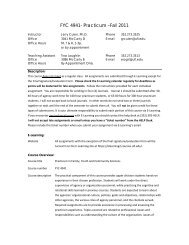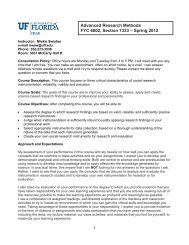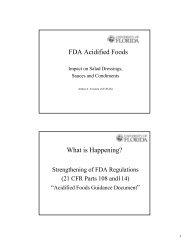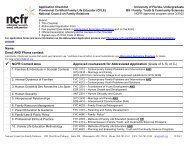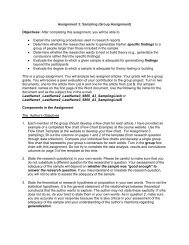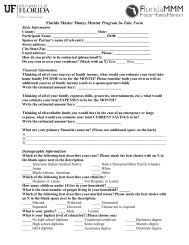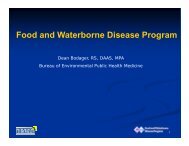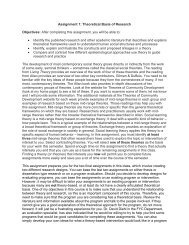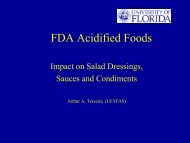Vibrio vulnificus: A Health Professional's Guide to Infection ...
Vibrio vulnificus: A Health Professional's Guide to Infection ...
Vibrio vulnificus: A Health Professional's Guide to Infection ...
You also want an ePaper? Increase the reach of your titles
YUMPU automatically turns print PDFs into web optimized ePapers that Google loves.
<strong>Vibrio</strong> <strong>vulnificus</strong><br />
A <strong>Health</strong> Professional’s <strong>Guide</strong> <strong>to</strong><br />
<strong>Infection</strong>, Prevention & Treatment
Presenter:<br />
Roberta M. Hammond, Ph.D.<br />
Food and Waterborne Disease Coordina<strong>to</strong>r<br />
Bureau of Environmental Epidemiology<br />
4052 Bald Cypress Way, Bin #A08<br />
Tallahassee, FL 32399-1712<br />
Phone: (850) 245-4116<br />
Fax: (850) 922-8473<br />
E-mail: roberta_hammond@doh.state.fl.us<br />
2
3<br />
This presentation is part of a<br />
national effort <strong>to</strong> promote<br />
education <strong>to</strong> health care<br />
providers, their high risk patients<br />
and other consumers regarding<br />
<strong>Vibrio</strong> <strong>vulnificus</strong> and ways <strong>to</strong><br />
prevent it.<br />
The Department of <strong>Health</strong> and<br />
the Department of Agriculture<br />
and Consumer Services are<br />
collaborative partners on this<br />
project. Funding for this project<br />
has been provided by the<br />
Department of Agriculture and<br />
Consumer Services and the<br />
Interstate Shellfish Sanitation<br />
Conference.<br />
Florida Department of Agriculture and Consumer Services<br />
CHARLES H. BRONSON, Commissioner
<strong>Vibrio</strong>s<br />
V. <strong>vulnificus</strong><br />
V. cholera 01<br />
V. cholera non-01<br />
V. parahaemolyticus<br />
V. alginolyticus<br />
V. fluvialis<br />
V. hollisae<br />
V. mimicus<br />
V. carchariae<br />
V. cincinnatiensis<br />
V. damsela<br />
V. furnissii<br />
V. metschnikovii<br />
4
<strong>Vibrio</strong> <strong>vulnificus</strong>: : What is it<br />
<br />
Occurs naturally in coastal<br />
waters - especially in warm<br />
months<br />
Can cause illness: wound<br />
infections, gastroenteritis,<br />
primary septicemia<br />
Associated foods -<br />
primarily raw oysters, but<br />
also clams, mussels, and<br />
crabs<br />
Not the result of fecal<br />
pollution or poor product<br />
handling<br />
5<br />
01/23/98
Habitat<br />
• Oysters are filter-feeders<br />
• <strong>Vibrio</strong>s attach <strong>to</strong> plank<strong>to</strong>n<br />
• Oysters filter & concentrate vibrios in oyster<br />
tissues ~100x<br />
• Rapid multiplication in warm conditions after<br />
harvest<br />
6
• Low salinity<br />
Optimal Conditions<br />
• Warm temperatures (86 - 95º F)<br />
• Best conditions in May-Oc<strong>to</strong>ber<br />
• Highest number of cases same period<br />
7
Illnesses Caused by<br />
<strong>Vibrio</strong> <strong>vulnificus</strong><br />
Wound infections<br />
Gastroenteritis<br />
Primary septicemia<br />
No outbreaks reported, only sporadic<br />
cases<br />
8
Infective Dose<br />
Unknown for healthy persons, but for<br />
high-risk people, septicemia can<br />
presumably occur with < 100 <strong>to</strong>tal<br />
organisms<br />
9
Clinical Diagnosis<br />
Culture of V. <strong>vulnificus</strong><br />
from<br />
• wounds,<br />
• diarrheic s<strong>to</strong>ols, or<br />
• blood<br />
10
Diagnosis<br />
Symp<strong>to</strong>ms<br />
• Gastrointestinal illness<br />
• Fever<br />
• Shock<br />
After<br />
• Ingestion of raw seafood (especially oysters)<br />
• Wound infection after exposure <strong>to</strong> seawater<br />
11
How<br />
Wound infections<br />
• Contaminating an open wound with sea<br />
water harboring the organism, or<br />
• Lacerating part of the body on coral, fish,<br />
etc. followed by contamination with the<br />
organism.<br />
Range from<br />
• Mild, self-limited lesions <strong>to</strong><br />
• Rapidly progressive cellulitis and myositis<br />
• Can mimic clostridial myonecrosis<br />
12
Gastroenteritis<br />
Consumption of raw or undercooked<br />
seafood, primarily molluscan shellfish<br />
containing the organism can cause<br />
gastroenteritis in otherwise healthy<br />
individuals.<br />
13
Primary Septicemia<br />
Microorganism enters the blood stream<br />
Resulting in septic shock<br />
Hypotension (death in 90% cases)<br />
Distinctive bulbous skin lesions<br />
Followed by death in @ 50% of cases<br />
14
Symp<strong>to</strong>mology<br />
• Early ID & treatment critical, rapid<br />
progression in<strong>to</strong> death<br />
• Extensive necrosis & tissue destruction<br />
around wounds and lower extremities,<br />
requiring surgical debridement <strong>to</strong> avoid<br />
amputation<br />
• Fluid leakage from capillaries in<strong>to</strong> tissues<br />
causing shock<br />
• Septicemia - bacteria in blood<br />
15
Key Characteristics<br />
• Highly invasive through host tissues<br />
• Resists host defenses<br />
• Very rapid growth in tissues, especially<br />
where iron present<br />
• Highly destructive of tissues -<br />
extracellular <strong>to</strong>xins & enzymes<br />
16
Examples of <strong>Vibrio</strong> <strong>vulnificus</strong> cellulitis and lesions:<br />
17
Treatment<br />
• Wound infections & primary septicemia<br />
require antimicrobial treatment. Most<br />
effective:<br />
– tetracycline,<br />
– fluoroquinolones (e.g. ciprofloxacin);<br />
– 3rd generation cephalosporins (e.g. ceftazidime),<br />
– aminoglycosides (e.g. gentamicin)<br />
• Early administration may reduce morbidity &<br />
mortality associated with infection<br />
18
People at High Risk<br />
Liver disease - accounts for most cases<br />
of severe illness<br />
Diseases of the s<strong>to</strong>mach<br />
Diabetes<br />
AIDs or HIV positive<br />
Impaired immune systems due <strong>to</strong><br />
medication or chronic illness<br />
19
Who’s s getting sick<br />
5 states account for 79% of all cases in<br />
last decade (178/224)<br />
– Florida 36%<br />
– Texas 12%<br />
– Louisiana 11%<br />
– California 11%<br />
– Alabama 9%<br />
20
Restaurant or Home “Cooked”<br />
• 70% ate shellfish in restaurants<br />
– More frequent in Texas 91% & Florida<br />
79%; Louisiana, Alabama, California ~50%<br />
• 26% ate shellfish at home<br />
– California 44%, Alabama 37%, Louisiana<br />
29%, Florida 18%, Texas 3%<br />
Implications for<br />
awareness campaign<br />
21
Composite Sketch of the Victim<br />
Male (85% of cases)<br />
White (77%)<br />
• Hispanic 88% in California, 21% Texas<br />
• Asian 13% in Louisiana<br />
40-59 years old (53 years mean &<br />
median)<br />
• Slightly younger in Texas & California<br />
22
Comparative Risk<br />
Persons with liver disease at very high<br />
risk for serious illness & death following<br />
exposure <strong>to</strong> V. <strong>vulnificus</strong><br />
• RR of infection after exposure 30x higher<br />
for person with liver disease<br />
• RR of death 200x higher for those with<br />
liver disease<br />
23
A Typical Case<br />
40 - 75 year old male<br />
Heavy drinker, cirrhosis<br />
Unaware of or in denial<br />
about dietary risks<br />
# oysters consumed: 3 -<br />
12<br />
Septicemia<br />
50% mortality<br />
24
Myth<br />
Oyster Eating Myths<br />
Fact<br />
Hot sauce or lemon juice will kill the<br />
bacteria<br />
Avoid polluted water and you’ll be<br />
fine<br />
You can tell a good oyster from a bad<br />
one<br />
Alcohol (beer, wine) kills harmful<br />
bacteria<br />
Just a few oysters can’t hurt<br />
Avoiding oysters in months without<br />
“R” is safe<br />
Among Latino populations:<br />
consumption of raw oysters<br />
enhances the likelihood of male<br />
children 25<br />
Active ingredients in hot sauce have<br />
no more effect on bacteria than water<br />
<strong>Vibrio</strong> <strong>vulnificus</strong> is a naturally<br />
occurring bacterium<br />
<strong>Vibrio</strong> <strong>vulnificus</strong> cannot be seen,<br />
smelled or tasted<br />
Alcohol impairs judgment, does not<br />
kill bacteria<br />
High risk people have died from<br />
eating just one oyster<br />
Higher counts of V.v. are more likely<br />
in warmer months, but have been<br />
reported year-round<br />
Oyster consumption does not<br />
influence genetics
Consumer Awareness<br />
• 43% of all consumers are unfamiliar with any at-risk group.<br />
• Consumer awareness that people with liver disease are at<br />
higher risk of illness is moderate (50%).<br />
• Consumer awareness that people with diabetes are at<br />
higher risk of illness is minimal (19%).<br />
• Consumers with any risk fac<strong>to</strong>r are significantly more<br />
aware of who should avoid raw oysters than those with no<br />
known risk fac<strong>to</strong>r.<br />
26<br />
Source: A Baseline Survey of Raw Oyster Consumers in Four States by<br />
Jennifer Flattery, MPH and Michelle Bashin, MHS (ISSC)
Consumer Risk Reduction Measures<br />
• 37% at risk consumers are eating oysters less often<br />
primarily for health reasons.<br />
• 42% of at risk consumers are doing nothing <strong>to</strong> reduce<br />
their risk of illness.<br />
• Actions taken by at risk consumers <strong>to</strong> reduce their<br />
risk of illness are usually ineffective (see myths)<br />
27<br />
Source: A Baseline Survey of Raw Oyster Consumers in Four States by<br />
Jennifer Flattery, MPH and Michelle Bashin, MHS (ISSC)
28<br />
Prevention<br />
High risk groups should avoid consumption of raw<br />
shellfish (or any raw animal protein)<br />
Cooking shellfish <strong>to</strong> certain temperatures for specified<br />
time periods will kill the organism (along with many<br />
other pathogens)<br />
Warnings regarding high risk groups and raw shellfish<br />
consumption are required <strong>to</strong> be posted in Florida at<br />
restaurants and retail seafood markets<br />
Industry and regula<strong>to</strong>rs are considering several post<br />
harvest treatments (PHTs) that could eliminate the<br />
organism in oysters including:<br />
• Irradiation<br />
• Mild pasteurization<br />
• Pressure treatments<br />
• Freezing and frozen s<strong>to</strong>rage
2004<br />
2003<br />
29<br />
30<br />
25<br />
20<br />
15<br />
10<br />
5<br />
0<br />
Number of V. <strong>vulnificus</strong> Cases Reported in Florida, 1988-2004<br />
Shellfish<br />
Wound<br />
Unknow n<br />
1990<br />
1991<br />
1992<br />
1993<br />
1994<br />
1995<br />
1996<br />
1997<br />
1998<br />
1999<br />
2000<br />
2001<br />
2002<br />
Year<br />
1989<br />
1988<br />
Number of Cases
2004<br />
1988<br />
30<br />
12<br />
10<br />
8<br />
6<br />
4<br />
2<br />
0<br />
Number of V. <strong>vulnificus</strong> Deaths Reported in Florida, 1988-2004<br />
Shellfish<br />
Wound<br />
Unknow n<br />
2003<br />
1989<br />
1990<br />
1991<br />
1992<br />
1993<br />
1994<br />
1995<br />
1996<br />
1997<br />
1998<br />
1999<br />
2000<br />
2001<br />
2002<br />
Year<br />
Number of Deaths
<strong>Vibrio</strong> <strong>vulnificus</strong> Cases and Deaths Associated With Oyster Consumption,<br />
Florida, 1988-2004<br />
Number of Cases/Deaths<br />
18<br />
16<br />
14<br />
12<br />
10<br />
8<br />
6<br />
4<br />
2<br />
Cases<br />
Deaths<br />
0<br />
1988<br />
1989<br />
1990<br />
1991<br />
1992<br />
1993<br />
1994<br />
1995<br />
1996<br />
1997<br />
1998<br />
1999<br />
2000<br />
2001<br />
2002<br />
2003<br />
2004<br />
Year<br />
Total Shellfish Cases, 1988-2004: 167 Total Deaths: 75 (45%)<br />
31
<strong>Vibrio</strong> <strong>vulnificus</strong>, , Florida, 2004<br />
Exposure<br />
Wound<br />
Oyster<br />
Unknown<br />
Total<br />
# Cases<br />
(deaths)<br />
12 (0 deaths)<br />
10 (4 deaths)<br />
15 (7 deaths)<br />
37 (11 deaths)<br />
2003: 28 wound (2 deaths), 14 oysters (3 deaths), 6<br />
unknown exposure (4 deaths): Total 48 (9 deaths)<br />
32
Investigation<br />
1. Clinical confirmation<br />
2. Epidemiological<br />
interviews<br />
3. Traceback of<br />
shellfish source<br />
33
Epidemiological Investigation<br />
Date and time of shellfish consumption<br />
or other exposure<br />
Date and time of symp<strong>to</strong>m onset<br />
Symp<strong>to</strong>ms and duration<br />
Pre-existing conditions<br />
Date of hospitalization<br />
Date of death (where applicable)<br />
34
Traceback Investigation<br />
NSSP Model Ordinance<br />
for molluscan shellfish<br />
classifies dealer types and requirements<br />
shellfish tag information<br />
• dealer name and address<br />
• certification number<br />
• date of harvest<br />
• harvest location<br />
35
Barriers <strong>to</strong> Traceback of Shellfish<br />
Tags not kept by<br />
seller<br />
Invoices not kept by<br />
seller<br />
Numerous<br />
intermediate sellers<br />
No lef<strong>to</strong>ver shellfish<br />
available<br />
36
37<br />
Information Coordination<br />
Between physicians,<br />
labora<strong>to</strong>ries and health<br />
departments<br />
Between labora<strong>to</strong>ries<br />
and health<br />
departments<br />
Between state<br />
agencies<br />
Between state and<br />
federal agencies
Proper Cooking Temperatures for Oysters<br />
and Clams<br />
• In the shell: use small pots so the shellfish in the<br />
center are thoroughly cooked<br />
– Boiling: after the shells open, boil another 3-5 minutes<br />
– Steaming: in a pot that is already steaming, cook for<br />
another 4-9 minutes<br />
• Shucked oysters<br />
– Boil or simmer for at least 3 minutes or until edges curl<br />
– Fry at 375 o for at least 3 minutes<br />
– Broil 3 inches from heat for 3 minutes<br />
– Bake at 450 o for 10 minutes<br />
38
39<br />
Recommendations<br />
Urge at-risk patients <strong>to</strong> avoid eating raw shellfish;<br />
<strong>to</strong> eat only shellfish that has been thoroughly<br />
cooked.<br />
Urge at-risk patients who are insistent on<br />
consuming raw shellfish <strong>to</strong> only consider shellfish<br />
that have been post-harvest treated and labeled <strong>to</strong><br />
kill <strong>Vibrio</strong> <strong>vulnificus</strong> bacteria<br />
Suspect V. <strong>vulnificus</strong> infection in those at risk who<br />
have recently eaten shellfish or been exposed <strong>to</strong><br />
warm sea water.
40<br />
Selected <strong>Vibrio</strong> <strong>vulnificus</strong> Education Activities<br />
in Florida<br />
Annual press releases and media interviews<br />
Pamphlets, posters and displays at conferences (FEHA/FPHA<br />
2004, FDA, FNA, etc.)<br />
Pamphlets <strong>to</strong> liver disease support groups<br />
This module presented <strong>to</strong> multiple professional associations<br />
and agencies:<br />
‣ FMA<br />
‣ DBPR<br />
‣ FL Dietetic Assn (FDA)<br />
‣ FL Academy of Physician Assistants (FAPA)<br />
‣ Local chapters of FDA and FNA<br />
‣ 2005 – NEHA and CSTE<br />
2004 Train-the-trainer workshop with other Gulf Coast states<br />
Scholarly articles
Florida <strong>Vibrio</strong> <strong>vulnificus</strong> Workgroup: Florida<br />
<strong>Vibrio</strong> <strong>vulnificus</strong> Risk Reduction Plan for Oysters<br />
Lead agency: DOACS Molluscan Shellfish<br />
Program<br />
With participants from the Florida shellfish<br />
industry (oyster dealers, harvesters, aquaculture),<br />
academia (UF), county extension<br />
Implements ISSC requirement for states having<br />
more than 2 confirmed V.v. cases traced <strong>to</strong> raw<br />
oyster consumption through.<br />
‣ Consumer education<br />
‣ Processing incentives<br />
‣ Processing controls<br />
41
Source information on <strong>Vibrio</strong> <strong>vulnificus</strong><br />
42<br />
CDC <strong>Health</strong> Topics A-Z:<br />
http://www.cdc.gov/ncidod/dbmd/diseaseinfo/<br />
vibrio<strong>vulnificus</strong>_g.htm<br />
FDA BadBug Book:<br />
http://www.cfsan.fda.gov/~mow/chap10.html<br />
ISSC: http://www.issc.org/ (V. <strong>vulnificus</strong><br />
consumer information and education<br />
brochure order forms)
43<br />
Please contact us if you have any questions


